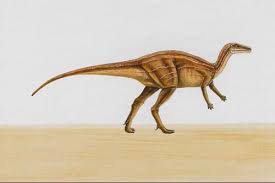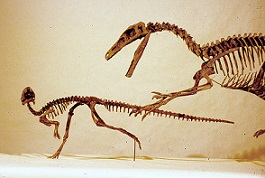
Orodromeus is a genus of Dinosaur that belongs to the group of small herbivorous dinosaurs known as ornithopods. It is a fascinating creature that offers valuable insights into the diversity and behavior of dinosaurs during the Late Cretaceous period. This genus has been identified primarily from fossils discovered in North America and is a subject of great interest for paleontologists and dinosaur enthusiasts alike.
The name Orodromeus is derived from Greek words, with oros meaning mountain and dromeus meaning runner, indicating its association with both agility and its likely habitat. The dinosaur's specific species is named Orodromeus makelai, which honors the Makela family, who provided crucial support for paleontological research in the region.
| Name: | Adeopapposaurus dinosaurs |
| Size: | Around length:6.5 feet (2 meters);weight:100 to 200 pounds (45 to 90 kilograms). |
| Main Facts: | Orodromeus was a small, agile, herbivorous dinosaur that lived in the Late Cretaceous and potentially exhibited social behavior. |
Orodromeus lived approximately 76 to 65 million years ago, during the Late Cretaceous period. This was a time when dinosaurs roamed diverse ecosystems, and the landscape of North America was vastly different from what we see today. The discovery of Orodromeus fossils contributes significantly to our understanding of the ancient world and the variety of life forms that thrived during this period.

Orodromeus,a small herbivorous dinosaur, had a slender build with a length of approximately 6.5 feet (2 meters). It was bipedal, walking on its hind legs, and featured a beak-like snout, indicating a herbivorous diet. With a lightweight structure, it likely weighed around 100 to 200 pounds (45 to 90 kilograms).
Fossils suggest it had adaptations for agility and quick movement. Orodromeus' skeletal features and social behavior, inferred from group findings, contribute to our understanding of its physical characteristics and potential herd dynamics during the Late Cretaceous period.
The discovery of Orodromeus has contributed to our understanding of dinosaur locomotion. Research indicates that it was likely an agile and quick-moving dinosaur, which is supported by its adaptations for bipedalism. Additionally, its lightweight build and leg proportions suggest that it was capable of running at moderate speeds, potentially allowing it to escape from predators or to forage efficiently.
While Orodromeus is relatively well-represented in the fossil record, some aspects of its biology and ecology remain uncertain due to gaps in our understanding. As with many dinosaur species, continued research and new discoveries may shed further light on the life and habits of Orodromeus.
Orodromeus is a small herbivorous dinosaur from the Late Cretaceous period, approximately 76 to 65 million years ago. Belonging to the ornithopod group, it was a bipedal dinosaur, walking on its hind legs, and measured about 6.5 feet (2 meters) in length. Its lightweight build and beak-like snout suggest it was specialized for consuming plant material. Fossils of Orodromeus have been found in North America, offering valuable insights into the diversity of life during this time.
It is believed to have been an agile and quick-moving dinosaur, possibly capable of running at moderate speeds. Additionally, evidence suggests that Orodromeus lived in social groups or herds, providing a glimpse into the social behavior of dinosaurs during the Late Cretaceous. Its discovery continues to contribute to our understanding of the fascinating world of ancient dinosaurs.
Orodromeus, like many other ornithopods, was a bipedal dinosaur, walking on its hind legs.
It had a beak-like snout, indicating a herbivorous diet similar to other ornithopods.
Orodromeus likely lived in social groups or herds, a common behavior observed in some other dinosaur species.
Orodromeus was relatively small compared to some other dinosaurs.
Its physical adaptations, including its lightweight build and agility, may have differed from larger dinosaur species.
Orodromeus belonged to the specific group of ornithopods known as hypsilophodontids, which had their unique features and characteristics.